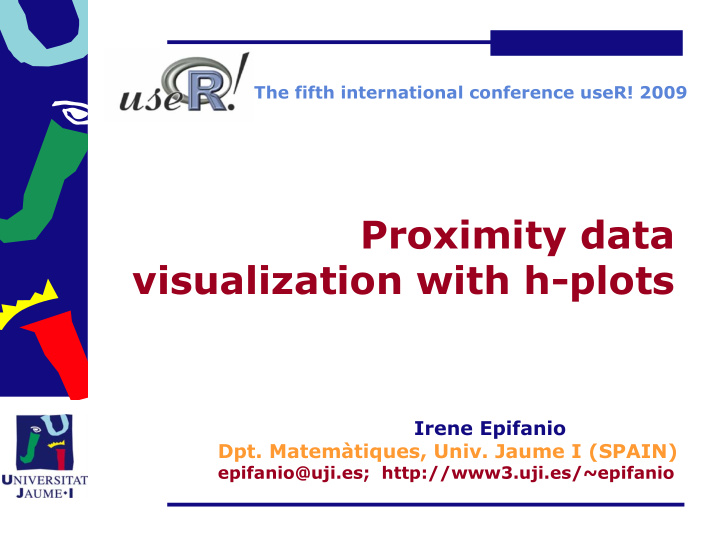



The fifth international conference useR! 2009 Proximity data visualization with h-plots Irene Epifanio Dpt. Matemàtiques, Univ. Jaume I (SPAIN) epifanio@uji.es; http://www3.uji.es/~epifanio
Outline � Motivating problem � Methodology � Small-size examples � Point patterns � Conclusions
Motivating problem In Ayala et al. 2006: to find groups corresponding with different morphologies of the corneal endothelia Different dissimilarities (non-metric) between human corneal endothelia.
Motivating problem Corneal endothelia described by bivariate point patterns (centroids and triple points). Different dissimilarities (triangle inequality is not hold) between point patterns.
Methodology: h-plot X data matrix, S covariance matrix: λ 1 , λ 2 largest eigenvalues, q 1 , q 2 unit eigenvectors: Rows h j of matrix H 2 have properties:
Methodology: h-plot We do not have a classical data matrix, but a dissimilarity matrix, D : d ij represents the dissimilarity from the object i to object j . Asymmetric relationship ( d ij ≠ d ji ): we can consider the variable measuring dissimilarity from j to other objects ( d j. ) and the dissimilarity to j ( d .j ). With a symmetric dissimilarity ( d j. = d .j ): variable j represents dissimilarity with respect j. Euclidean distance between h j and h i in h-plot is sample standard deviation of difference between variables d j. and d i. . If these variables are similar, their difference, and therefore, its standard deviation will be small.
Comparison � Classical Metric Multidimensional (cmdscale) � Isomap (Tenenbaum et al., 2000) � Kruskal's Non-metric Multidimensional Scaling (isoMDS) and Sammon's Non-Linear Mapping (sammon): Library MASS. (0-1): s imilarity Congruence coefficient of two configurations X and Y. 1 is achieved if X and Y are perfectly similar geometrically (match by rigid motions and dilations).
Example 1 If triangle inequality is not hold, although d ij is small, variables d j. and d i. can be very different, and the objects i and j should not be represented near.
Example 2 The observed values for variables d j. and d i. coincide, but d ij is not zero, therefore the observed difference between d j. and d i. is zero for all the observed objects, except for the objects i and j.
Example 3 Asymmetric data: d is not a distance. Even when d jj > 0. Dissimilarity formed by the variables giving the dissimilarity from each Morse code (i.e. d i. , where code i-th is first presented), and the variables giving the dissimilarity to each Morse code (i.e. d .i , where code i-th is second presented).
Point patterns: simulation Same experiments considered in Ayala et al. (Clustering of spatial point patterns. Computational Statistics & Data Analysis. 50 (4) 1016-1032, 2006): Three experiments for simulated Strauss processes with different parameters. In each experiment, the same experimental setup: three different groups, each of them composed of 100 point patterns. Therefore, 3 dissimilarity matrices of 300x300. Considered dissimilarity (based on the log rank statistic applied to the nearest-neighbor distances, Ayala et al. 2006) between point patterns is not a metric: triangle inequality is not hold. Libraries of R used: Splancs; Spatstat and Survival.
Point patterns: simulation Corsten and Gabriel (1976) goodness of fit for h-plotting in two dimensions:
Point patterns: Experiment 1 One of the 100 point patterns generated for each group. Note that we compute the dissimilarity between these point patterns, not inside them.
Point patterns: Experiment 1 Cmdscale a) isoMDS b) Sammon c) Isomap (25 d) neighbors)
Point patterns: Experiment 1 Besides the original dissimilarities, the ranking of the dissimilarities have been also considered (Seber 1984: if we have in mind cluster and pattern detection, then an expansion or contraction of the configuration could be more useful).
Point patterns: Endothelia The dissimilarity matrix is made up of dissimilarities based on the log rank statistic applied to the nearest-neighbor distance between triple points (Ayala et al. 2006), for 153 individuals. The unhealthy cases obtained in (Ayala et al. 2006) are represented by red triangles, while black circles are healthy cases.
Point patterns: Endothelia Cmdscale a) isoMDS b) Sammon c) Isomap (25 d) neighbors)
Point patterns: Endothelia (a) the original dissimilarities, and (b) the dissimilarity ranks.
Conclusions � Alternative method for displaying dissimilarity matrices, based on h-plots. � Good behavior through several examples (dissimilarity was not a metric). � Non-iterative method, very simple to implement and computationally efficient. � The representation goodness can also be easily assessed. � It can also handle naturally asymmetric data. � More illustrative results at: http://www3.uji.es/~epifanio/RESEARCH/hplot.pdf � Future work: instead of second order differences between variables that indicates dissimilarity with respect to an object: higher order differences. Although the simplicity could be lost.
Thanks for your attention
Recommend
More recommend